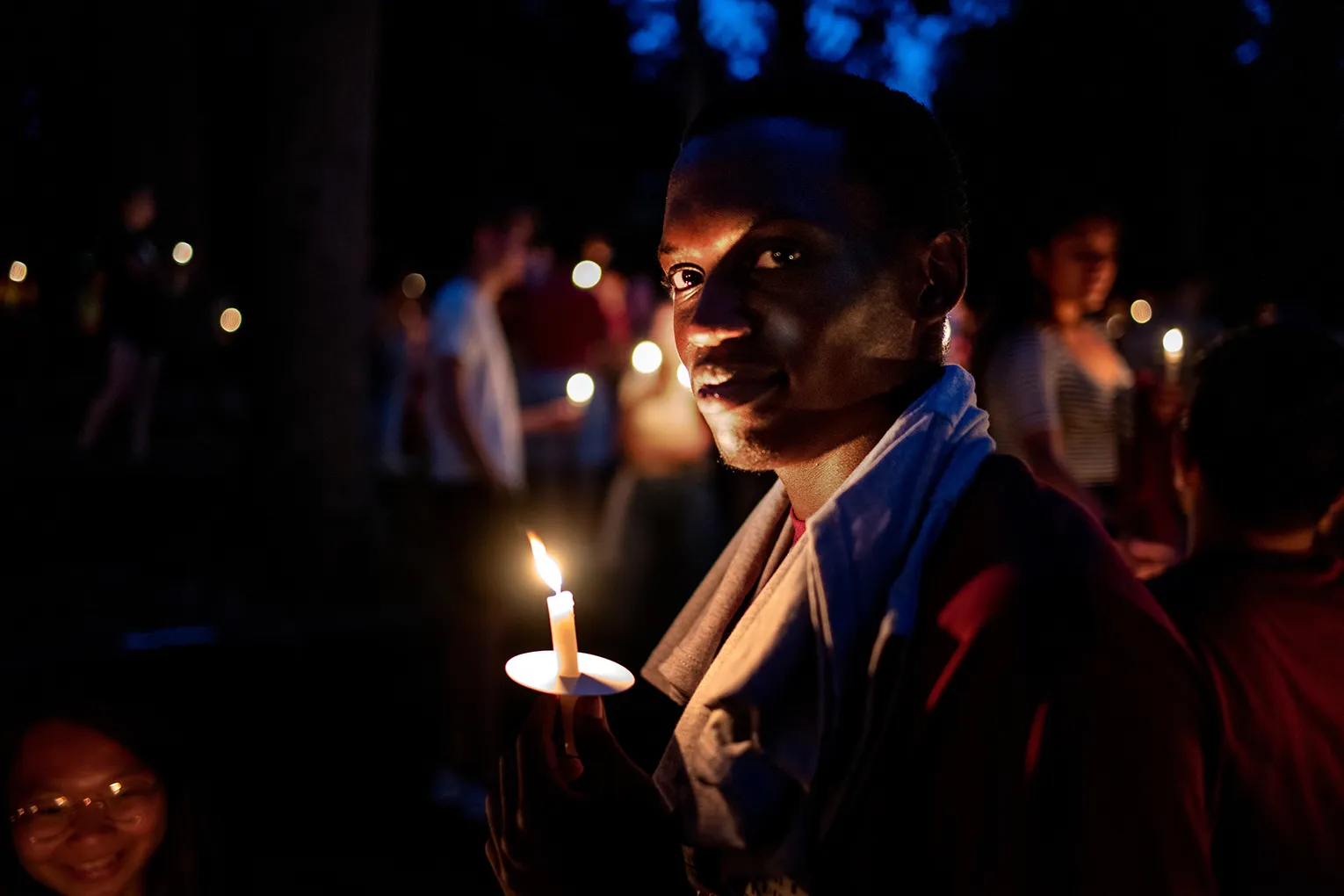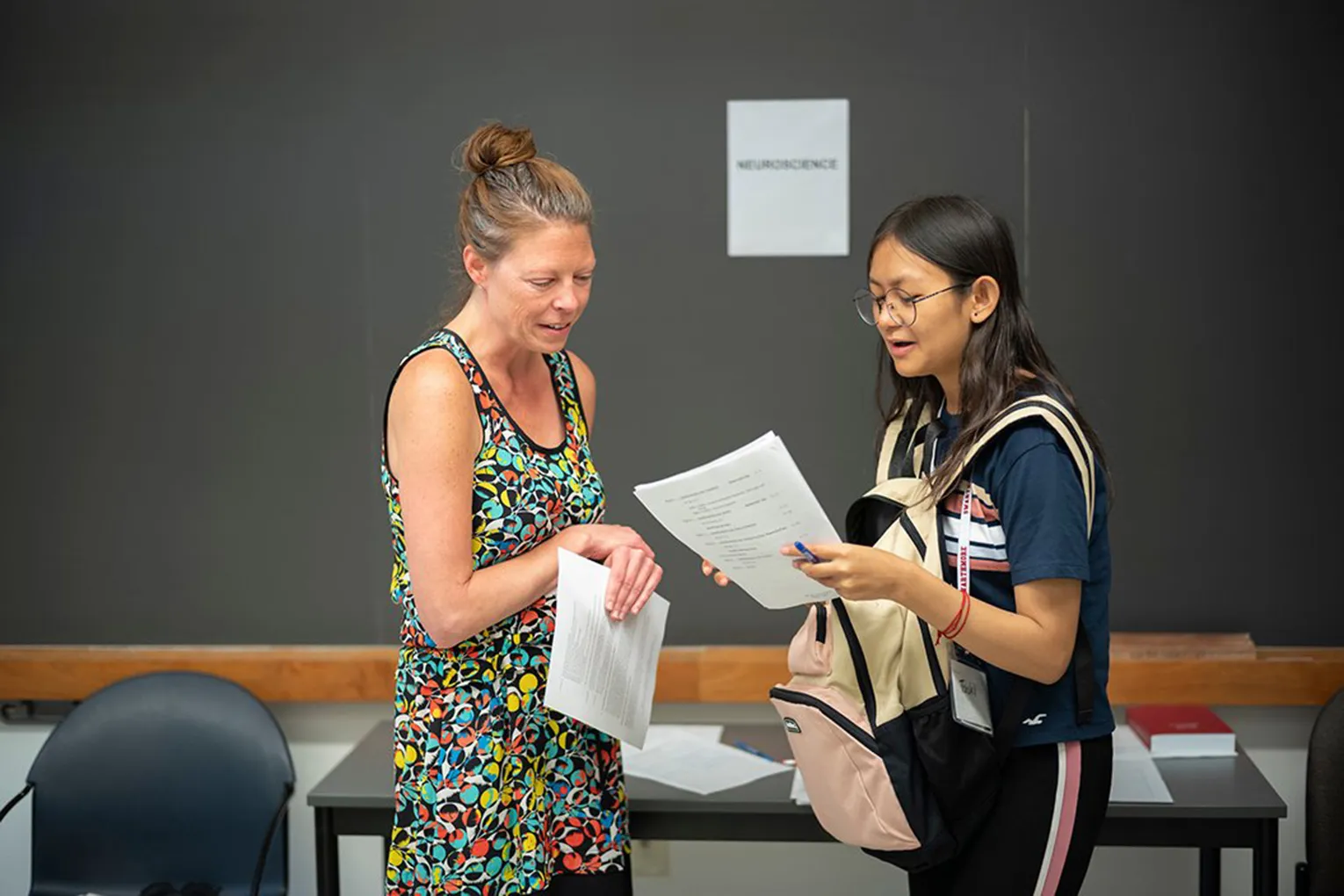The Swarthmore College Chinese Music Ensemble Performs Sunday, April 27th at 7:30pm in Lang Concert Hall

On Sunday, April 27 at 7:30 p.m., the Swarthmore College Chinese Music Ensemble will take the stage at Lang Concert Hall, presenting a vibrant array of pieces that reflect the deep regional and cultural diversity of Chinese music—and beyond.
This semester’s performance will be co-directed by Eric Hung, Visiting Associate Professor, and Guowei Wang, erhu virtuoso, composer, conductor, and arranger. While Wang customizes music to suit each player’s skill level, Hung brings a broad global perspective to the group. “This concert is really about showing how many of the instruments and sounds we associate with Chinese music come from a lot of different places,” Hung shared. “Chinese culture has always been influenced by other cultures, from Persia to India to Central Asia.”
In keeping with Hung’s idea of cross-cultural currents, this spring, the Chinese Music Ensemble concert will open with a guest performance by the Hafez Percussion Ensemble, a Philadelphia-based Arabic drumming group founded by educator and musician Hafez Kotain.
The ensemble draws its members from across the city, many of whom are connected to community schools and youth music programs. “There’s actually been an Arabic music presence in Philly for decades,” Hung shared. “Local universities and organizations like Al-Bustan Seeds of Culture have brought in top Arabic musicians and built infrastructures that allowed them to make a living in Philadelphia. Hafez Kotain teaches at Penn and in charter schools around the city.”
Hung, who is also a member of the Hafez Percussion Ensemble, emphasized the historical resonance: “The further west you go in China, the more Central Asian the music sounds. So we’re performing a piece from northwest China with a doumbek drum, because we don’t have the traditional drums from that region. My instrument is from Lebanon, and it actually sounds more at home in that context.”
Hung stresses that Chinese music encompasses a wide array of styles and sounds. "I could’ve brought in a South Asian or Mongolian group—Philly has all of that. But the point is to show that Chinese culture has never been isolated. It’s a convergence of influences, and bringing in another ensemble makes that tangible for the audience," he says.
Following Hafez’s opening act, the ensemble’s program includes traditional Chinese repertoire, contemporary arrangements, and even a few surprises. “We’re doing Happy Year, which anyone who’s lived in a Chinese-speaking community will recognize from storefronts and public speakers,” Hung said. “We also have an arrangement of a Chinese pop song, May Life Be Fulfilled, and we’re ending with Joyous Spring, which is probably the most difficult piece we’ve attempted this year.”
Hung is particularly excited to hear the intricate arrangements of three folk songs from different regions of China: Jasmine Flower (茉莉花), Flowing Stream (小河淌水), and A Single Bamboo Can Easily Bend (一根竹竿容易彎 ), performed by an erhu, yangqin, pipa, and guzheng quartet. “The arrangements are really cool,” Hung said, “and the students have worked hard to master them.”
One of the quartet members, Hillary Tran ’25, has played the pipa, a traditional Chinese lute, since the age of nine. “Our quartet process has been a lot of trial and error,” she said. “But it’s so satisfying when we finally get one measure right after playing it many times.” Tran is also excited to perform a pipa-guzheng duet at long last. “Elaina, the guzheng player I am doing it with, is fantastic, and I am absolutely in love with the piece, The Moon over the River on a Spring Night (春江花月夜). I've always had the challenge of blending my sound with the ensemble, since I've spent so many years playing solo. Learning to listen more closely and play in sync with others has been a real shift for me,” Tran explained.
Another standout of the night will be a solo performance by longtime ensemble member and student assistant Bua Boonkongchuen ‘25. She will perform a piece of Chinese music, accompanied by the orchestra, followed by a piece of Thai music arranged for a trio of Chinese instruments. “She’s brought Thai influences into our repertoire, which really reflects how interconnected these musical traditions are,” Hung noted.
One of the ensemble’s hallmarks is its diversity of experience. Some students, like Percy Pu ’27, are new to their instruments. “I play the dizi, which is similar to the Western flute, but made of bamboo. I started learning it when I joined the ensemble three semesters ago,” Pu explained. “This semester’s pieces for the wind section have been quite challenging. There are suddenly a lot of high-pitched notes and many of them are fast in speed. But I really love the Xinjiang tune Beneath the Kunlun Mountain—the folk melodies are so catchy.”
Others, like T Sallie ’25, are multi-year veterans: “I play erhu in the ensemble. I started simply playing cello in the dress rehearsal and concert … I decided I wanted to be part of the ensemble experience instead of joining for the end. I considered erhu since it was the most similar to the cello, and I was able to pick it up pretty easily. This is my third and final semester in the erhu section.”
Sallie emphasized how inclusive the ensemble is for all skill levels: “Wang [Guowei] writes parts to match each student’s level. This semester, I got to level up in terms of my personal music difficulty level … a lot of the erhu parts go higher than in past pieces, and it’s been fun to push myself.”
That spirit of challenge, growth, and camaraderie is part of what makes the ensemble experience so fulfilling. “Swarthmore students come from many different musical backgrounds,” Hung explained. “Some are nearly professional, others are complete beginners. The challenge is to bring everyone together to create something cohesive and meaningful.”
More than just a concert, the ensemble’s spring performance is a celebration of cultural dialogue, student artistry, and community connection. “Our performances are filled with months of practice, laughter, frustration, breakthroughs, and moments of connection, all meshed together with our unique understanding of the Chinese pieces,” said Tran. “You’ll hear us navigating different rhythms and harmonies, with each performance reflecting our individual interpretations and collective effort. It’s an experience that’s both therapeutic and full of energy, and that’s exactly why it’s worth seeing.”
The Swarthmore College Chinese Music Ensemble concert takes place on Sunday, April 27 at 7:30 p.m. in Lang Concert Hall. The event is free and open to the public.



